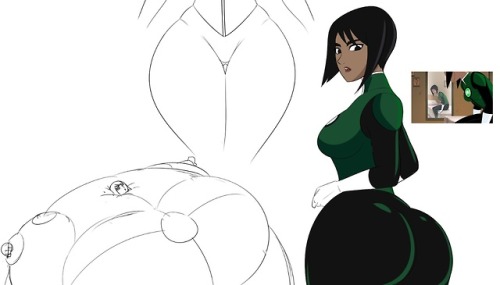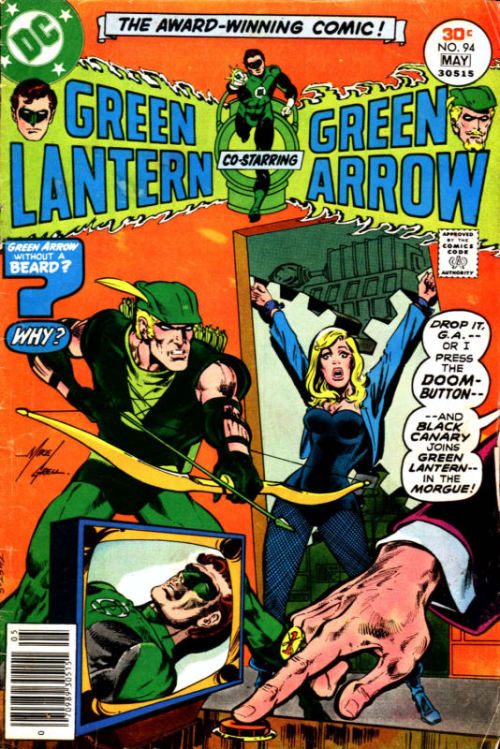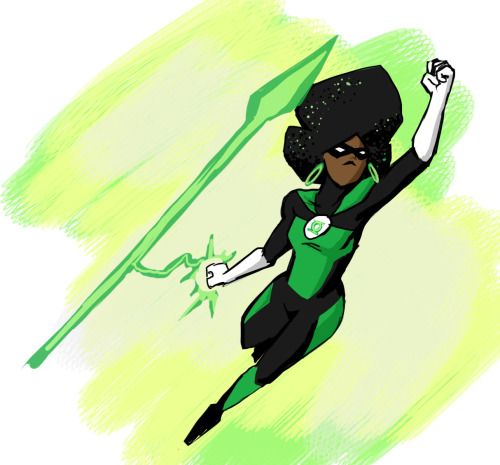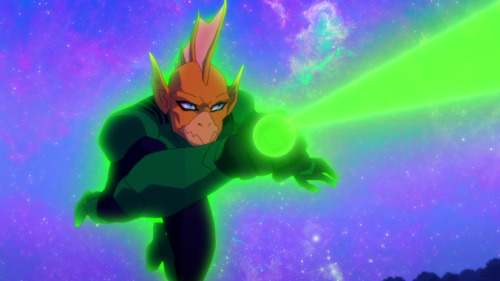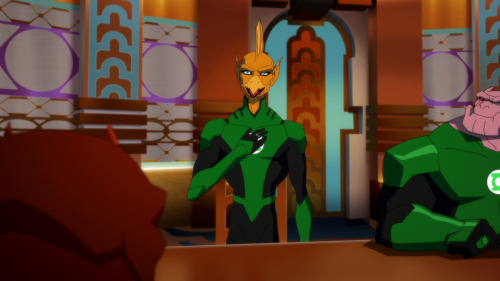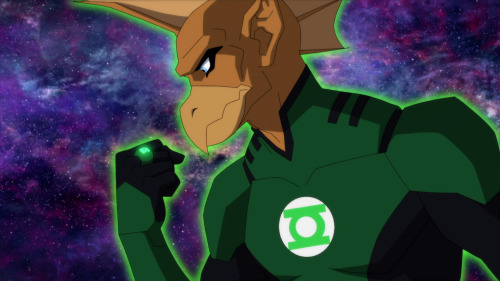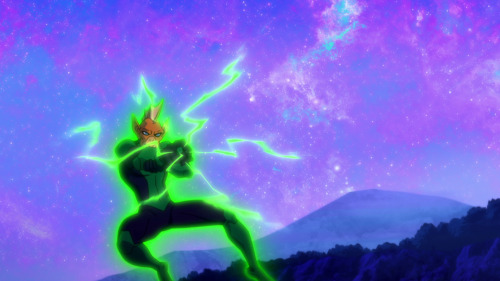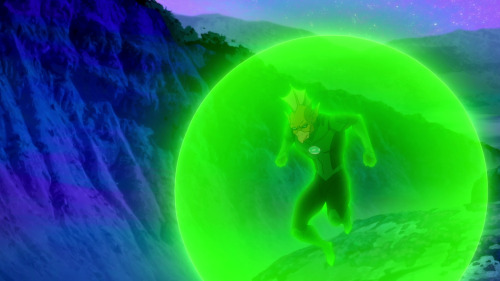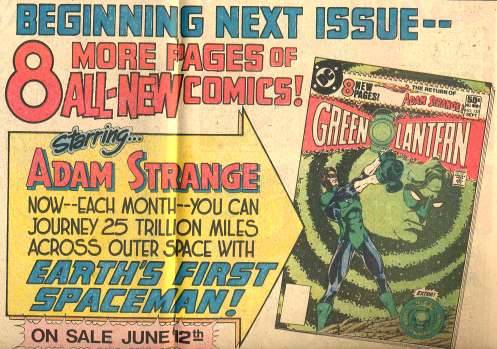#green lantern
Seen the red picture with a lighter red equal sign to promote gay rights. What if after all of that is done at the supreme court someone comes up with a ‘Save Young Justice and GLTAS’ logo that we all change our FB and tumblr pictures too and write on CN’s comment areas over and over? I’m not very good with organization and it seems to me that as unified as we are, why don’t we do this to present ourselves not as angry individuals but as a unified front?
Let’s do it for our fallen hero’s!
Jessica Cruz from the movie: Justice League vs The Fatal Five.
All plumped up and inflated! This was drawn last year and I finally got around to finishing it.
Post link
Just a sneak peek on what I’m working on after seeing Justice League vs Fatal Five. Jessica Cruz caught my attention. :>
Post link
Gumroad: gumroad.com/sexyversecomics
Jessica Cruz joins the cruise as she’s approached by a cute boy willing to keep her company! Who is it and will he be too much to handle for her?
Thanks to the great support we got this month there’s two bonus pages! Here’s the first and the second will be up in a week!
Post link
It had been a while since I’d picked up an issue of ACTION COMICS, but for whatever reason, after passing up the previous few issues, this one made the trip home. Might have been as simple as there being slim pickings on the rack that week in terms of new super hero comics of the type I knew I liked. It’s got a very nice cover by Jose Luis Garcia-Lopez, an artist’s artist who would go on to do tons of DC licensing artwork through the next decade, here inked by Bob Oksner, a combination I can’t recall seeing again.

Looking at this splash page, it may have been the call-out here for the Flash and Green Lantern that made the difference, as they were my two favorite heroes of the era. Also, it ran below my personal ten-year-old radar, but after a long and bitter public struggle, the creator byline for Jerry Siegel and Joe Shuster had been restored to all Superman stories, and appears here for the first time in my own chronology. I don’t know that I took any special note of it.

So what was going on in the life of the Man of Steel? Well, this was the conclusion to a multi-part story begun in the previous two pages. After the opening, a flashback let me know that Superman had seemingly been killed in battle with his recurring enemy, the space cowboy Terra Man. Superman wasn’t truly dead, in fact, but that didn’t stop him from tossing away his uniform Peter Parker-style. Or has he? The text informs the reader that the figure throwing his Superman costume into the sea on the splash page is neither Clark Kent nor Superman. Wha?? Meanwhile, a mysterious threadworn bum is also wandering around Metropolis in a fashion that makes it clear he’ll be important later.

Terra Man has cut off Metropolis from the rest of the world behind an impenetrable force-field–but that field isn’t so impenetrable that certain friends of the deceased Man of Steel cannot penetrate it. So it is that the Flash makes his entry into the story, ambushing Terra Man in the middle of Metropolis in the name of the fallen Superman. Flash puts up a good fight, but is suddenly and inexplicably blown out away from the fight. The culprit? Terra Man himself–who we learn is actually Superman himself, his appearance having been changed during his supposed demise to match that of his foe. Rather than trying to explain to the Flash what the truth is, the Man of Tomorrow used his super-breath to propel the Scarlet Speedster away from their conflict. But Superman himself has more questions than answers.
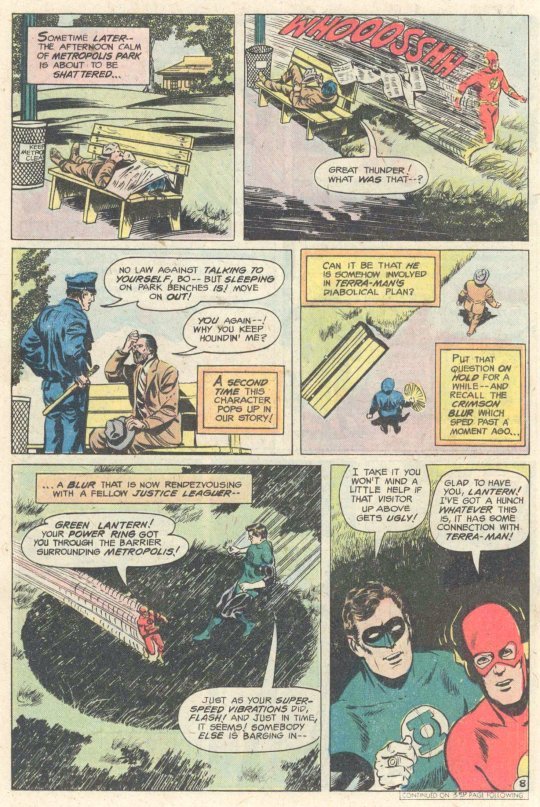
Recouping, Flash finds himself joined by his fellow JLA member Green Lantern, whose Power Ring was also able to get him within the force-field. But before the two super-friends can coordinate an attack on Terra Man, a flying saucer appears in the skies over Metropolis (having had no trouble getting in.) Flash and Green Lantern go to check it out, but are swiftly taken out of action by its advanced weapons. From afar, Super Terra Man has been watching, and his friends’ distress calls him back into the action.

The inhabitant of the spacecraft turns out to be the brother of the alien who, a hundred years ago, turned Terra Man from an orphaned child into a space cowboy–and he’s come back to take his revenge on the man who killed his brother. He pledges to hunt Super Terra Man down through Metropolis and destroy him. Meanwhile, the man who threw his Superman costume into the sea is revealed to be Gregory Reed, an actor from several previous Superman adventures who typically portrays the Man of Steel on film . With Superman dead, he felt there was no point in hanging onto his costume. But he can’t help but wonder what it must feel like to be the Man of Tomorrow…

Things race to a climax as the citizens of Metropolis are heartened to see a familiar red and blue streak in the sky: Superman lives! He attacks the flying saucer and defeats the alien, only to be ambushed himself by Terra Man. The appearance of Terra Man is enough to make the cop who harangued the ragged bum we saw earlier drop his disguise, revealing himself to be the true Terra Man. This is all part of the plan, though, since the fake Terra Man is, as we know, really Superman, and he kayos his enemy. The Superman who defeated the alien was Gregory Reed, his super-feats actually performed by Flash and Green Lantern incognito (Superman did get around to explaining his situation to them.). Now, with both Terra Man and the alien hunter neutralized and Superman’s features restored to their proper form, the story reaches its finale.
Post link
It’s kind of funny that the big mystery posited by this GREEN LANTERN cover is why Green Arrow is appearing here without his trademark beard. I mean, presumably he shaved it off, you know, no big mystery. But in this era in which such changes of costume and appearance were much more rare, I suppose this was potentially a big deal thing. No matter–I know that I’m spoiling things somewhat, but by the end of this two-parter, Ollie’s beard would miraculously be restored going forward.

GREEN LANTERN was a very schizophrenic comic book during this particular era. Clearly it had been brought back due to the reputation of its previous run (and potentially the belief that affidavit returns were responsible for its premature cancellation.) By that same token, it seemed like nobody involved was very anxious to dive back into the very heavy issue-of-the-issue style storytelling of that celebrated run. So what you were left with was two super hero friends whose natural spheres of operation were completely incompatible with one another.

And so you ended up with stories like this one, which was mostly a Green Arrow solo caper with Green Lantern in it slightly but then incapacitated. And no particular social issue being dissected at all. In this particular issue, Green Arrow is performing at Carol Ferris’s Thanksgiving party when government agents burst in and accosted him, carrying him off. Green Lantern, returning from space, intercedes, but then he immediately passes out, stricken with some unknown malady.
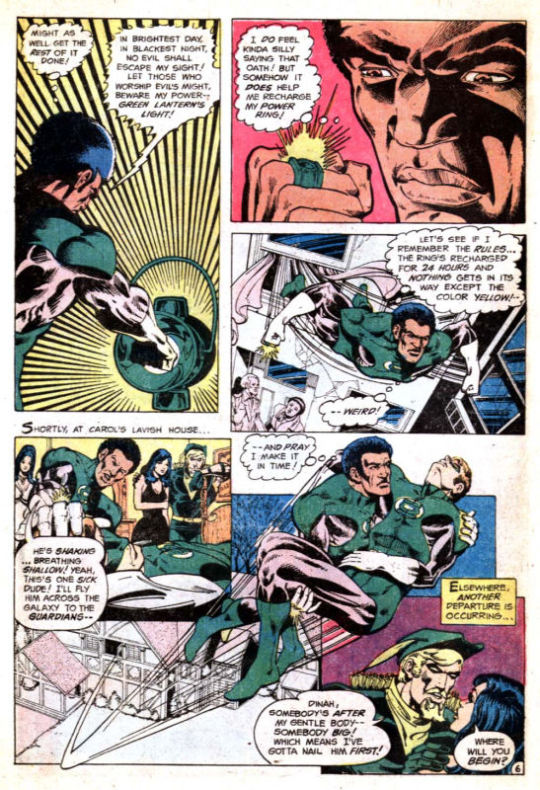
Figuring that the Lantern may have come down with some manner of space-plague, Green Arrow reaches out to John Stewart, Earth’s back-up Green Lantern, asking him to convey Hal to Oa and the Guardians, who will presumably know how to treat his illness. In the meantime, Ollie intends to track down the Colonel Krisp who was behind the attack on himself–and he’s in luck as one of the agents dropped a handily-labeled route map that he can follow. Ollie says goodbye to Dinah Lance, turning down her offer of help–but undaunted, she is determined to follow him as Black Canary.
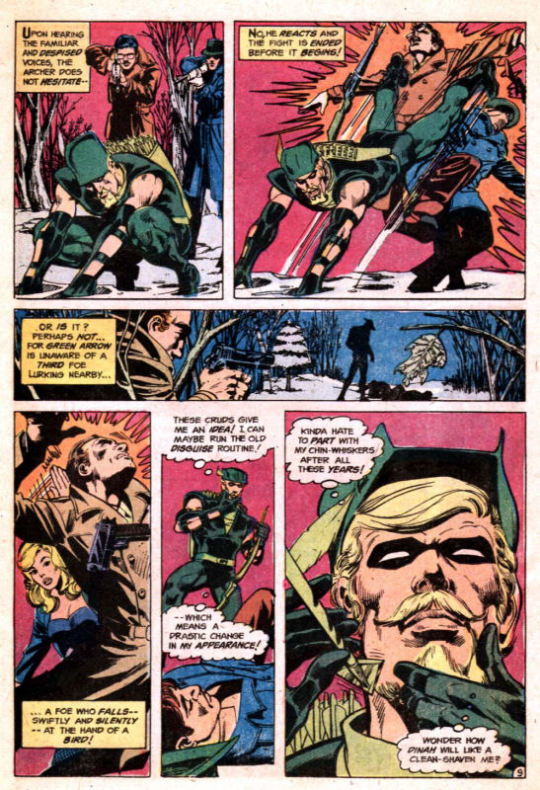
Green Arrow makes his way to the compound, and with the unseen aid of Black Canary kicks his way through the outer ring of security guards. In order to sneak into the place, Ollie decides to shave off his beard so he’ll look more like one of the guards. This gambit works for all of zero panels, as the Colonel sees him sneaking in and recognize him immediately despite his lack of chin-whiskers. He also spies the Black Canary, and ambushes her.

Discovered, Green Arrow continues to run a gantlet of attackers, and the mysterious Colonel Krisp is confident in his choice of Green Arrow for “the mission”. Meanwhile, off in space, en route to Oa, John and Hal run afoul of a neutron star, which threatens to suck them into its gravity well and to oblivion. For all that he struggles, John doesn’t have enough will-power to pull them clear of it.
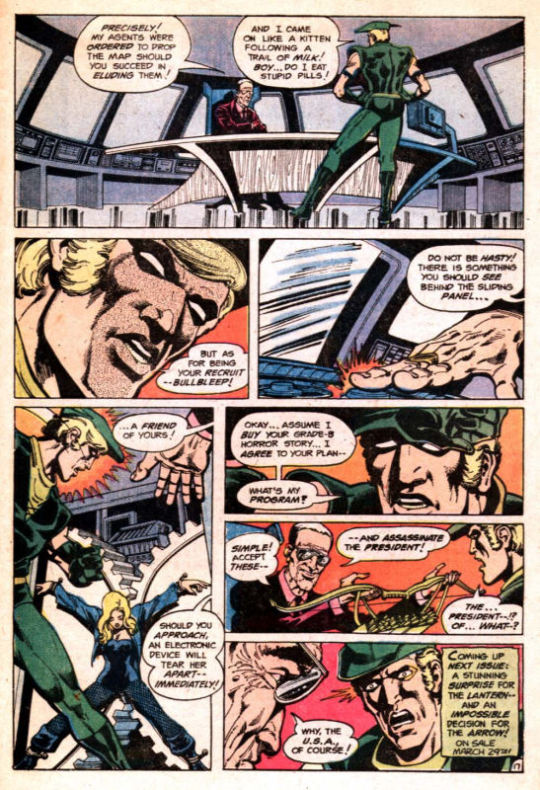
Back at the compound, Green Arrow finds himself face-to-face with Colonel Krisp, who tells him that all of this has been arranged for Green Arrow’s benefit, to test him–that map that he followed was deliberately planted, of course (Stupid Ollie!) Krisp’s got a mission that only Green Arrow can accomplish: he wants Ollie to assassinate the President of the United States. And he’s holding the Black Canary as leverage to get Green Arrow to go along with it–thus leading us back to our cover scene as the issue closes, something I hated when the Marvel books did it and didn’t really like any better here. Anyway, To Be Continued!
Post link
In January of 1977, I turned ten-years-old. And around that time, I would up getting my second book collection of vintage comic book stories–a book that, up until that point I didn’t even know existed. We found it in the remaindered section at Two Guys, a regional low-rent department store chain, kind of like the K-Mart of its day. And because I had money that had been given to me for my birthday, I was able to buy it. By that point, it was twelve years old and had gone through several printings–it was, in fact, the very first collection of vintage comic book stories ever published, coming out in 1965 just ahead of the Batman TV show craze.
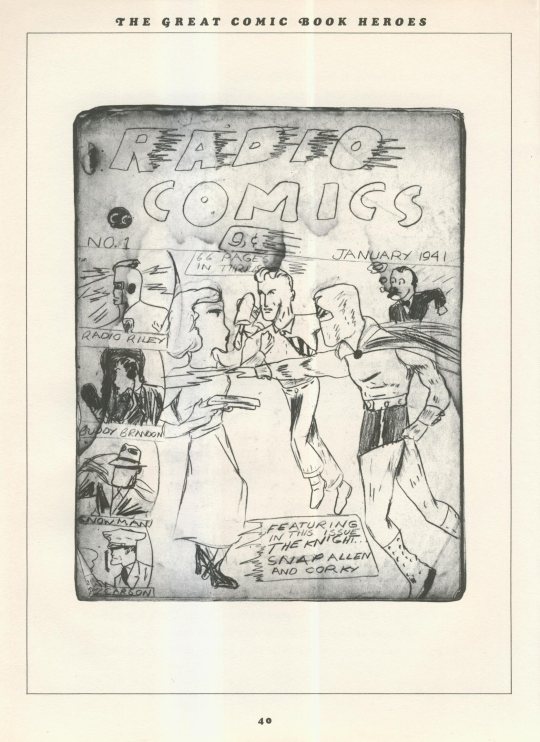
THE GREAT COMIC BOOK HEROES began life as an article that Jules Feiffer had written for Playboy magazine, of all places. It was a nostalgic look back, warts and all, at the comic books that were a part of his youth and the state of the industry a few years later when he was able to get into the business working for Will Eisner. From there, Feiffer went on to be a successful syndicated cartoonist, his strip primarily appearing in the Village Voice, as well as an accomplished playwright. He was so well-regarded, in fact, that he was able to convince a number of publishers to reprint stories from their back catalog in this hardcover collection–publishers who, up to this point, has never really worked in concert before.
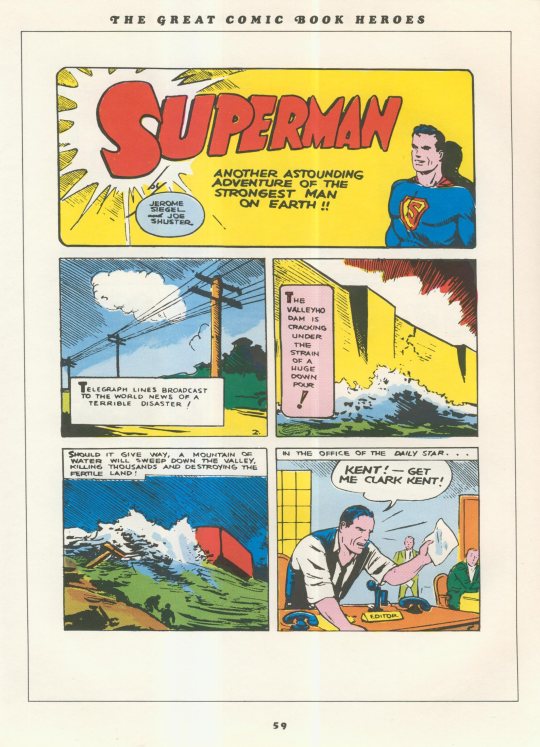
As no good reproduction materials existed, Feiffer worked in concert with DC’s Jack Adler to pioneered a process by which old comic books could be photographed under certain conditions to create a usable black line image, and then recolored. This same process was later used on many of DC’s reprints, in particular the FAMOUS 1st EDITION treasuries–I gather that the reason its use wasn’t more widespread is that it was more costly and time-consuming than was considered worthwhile for a regular comic book release.

Feiffer was also enough of a bigwig in 1965 that he was able to negotiate a minor detente in the legal agreement between DC/national Periodicals and Fawcett Publications, enough to allow him to reprint a single page’s worth of Captain Marvel. In 1977 when I read this book, I didn’t understand why this was a big deal (and in fact I had read this same story twice before already.) I believe it was the one and only exception ever granted, at least up until the point where DC began licensing the rights to Captain Marvel from Fawcett in 1973.
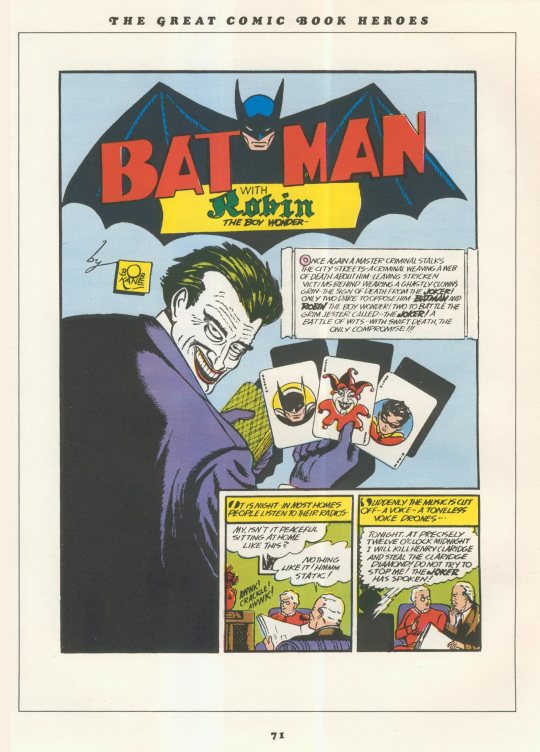
I will confess that, when I first bought this volume, I didn’t read any of Feiffer’s text. That seemed like work to me, who needed it? It was the stories that I was here for! I was hypnotized by the reproduction of one of the comic books that Feiffer had made and sold on the neighborhood street when he was a kid. I had begun to make my own comic books before this, and so this was a very primal point of connection for me–I think I may have read the text of just that one “chapter” (they were all short enough that they were only three or four pages long.)
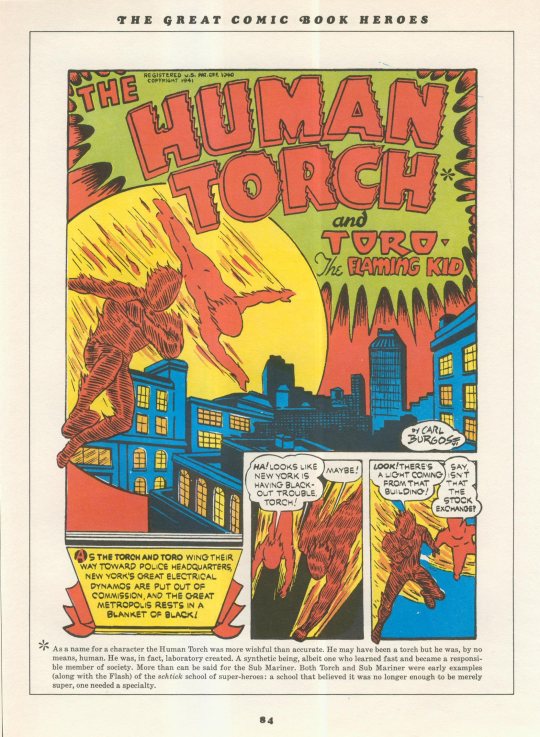
I also didn’t read the stories featuring the Human Torch, the Sub-Mariner and Captain America that were included in the volume. Why would I? I had learned from past experience that I adamantly disliked Marvel comics, decried them whenever I was asked about them, so there was no need to investigate these stories. It would literally be months, not until the summer of 1977, when, on one dull day with nothing better to do, I finally cracked and read through both Feiffer’s full text and the three Marvel stories. And they (along with the write-ups on Timely in the Steranko History of Comics, coming soon) were enough to compel me to give Marvel another chance. But we’ll get to that in due time.
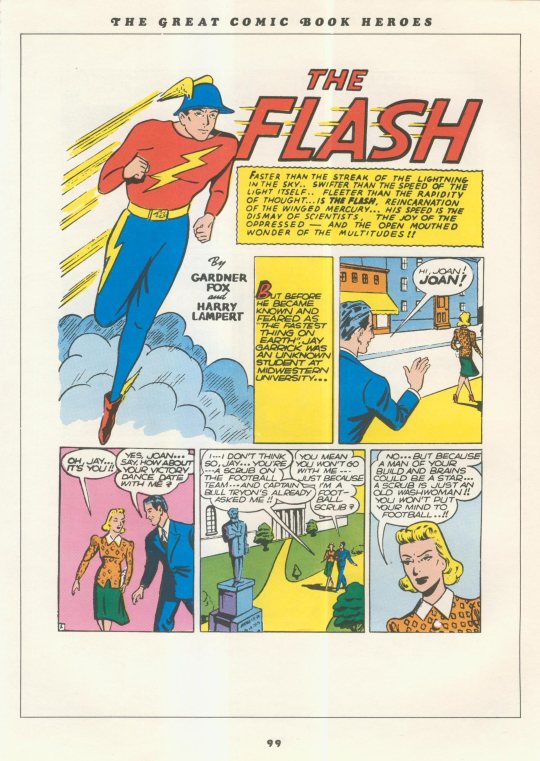
The one disappointing aspect of Feiffer’s book to me, coming to it twelve years later, is that there were already a number of stories in it that I’d read already. Because Feiffer tried to hit all of the mainstays of the big comic book houses in his reprints, and as often as possible, the opening or origin installments. The only times he varied from this approach was when there was some other aspect of the character or the strip that he was trying to highlight–a number of these series took a little while to completely crystallize in their final forms, and Feiffer took that into account when choosing his stories.
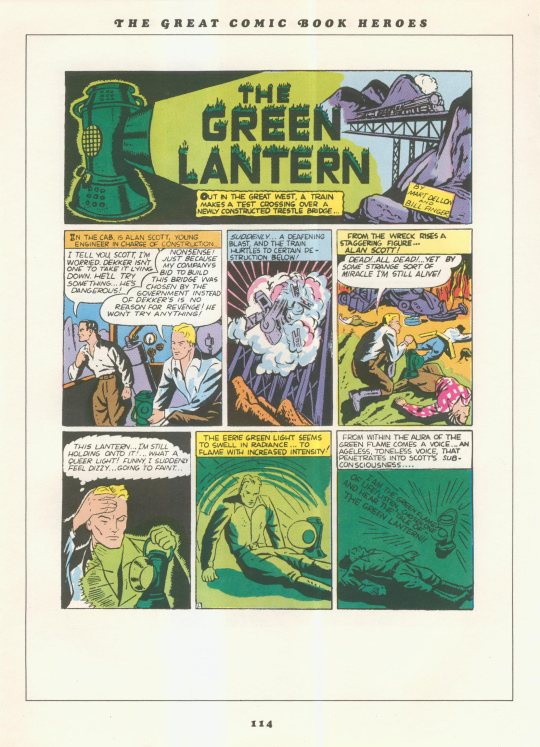
So what was reprinted in this volume? It opened with a two-page origin of Superman, taken not from ACTION COMICS #1 but rather from the more expanded version first shown in SUPERMAN #1. Thereafter, he ran a story that he sourced from SUPERMAN #3 but which was first published in ACTION COMICS #5. It’s really the first full story in which all of the quintessential elements of the Superman series coalesce: the Lois-Clark-Superman relationship in particular. There are several pages in the middle of it that were clearly reworked from newspaper strip samples, panels extended and reformatted into comic book pages haphazardly.

Following the single page of Captain Marvel he could show, Feiffer then reprints the origin of Batman, from BATMAN #1 (which I’d read), as well as the first story featuring the Joker (likewise). This was about a year in, by which point Robin had been introduced, and wit the debut of the Joker all of the elements were in place. But not new to me. Next was a relatively late Human Torch story from MARVEL MYSTERY COMICS #20–like Batman, by this point the Torch’s young partner Toro had come into the series, and it had settled down into typical super-heroics. But I didn’t read it, not yet.

A pair of stories that I’d already experienced came next: the first adventure of the Flash (my third copy of it!) from FLASH COMICS #1 and the first installment of Green lantern from ALL-AMERICAN COMICS #16. Next came a solo Spectre story from ALL-STAR COMICS #1. I was familiar with this early version of the Spectre from the FAMOUS 1st EDITION reprint of ALL-STAR #3, but he wasn’t especially interesting to me. Because he was already dead and could do literally anything, there wasn’t a lot of drama to be found in his stories. Even as a kid, this deficit was apparent to me. Superman, at least, had to struggle to accomplish whatever his goal was.
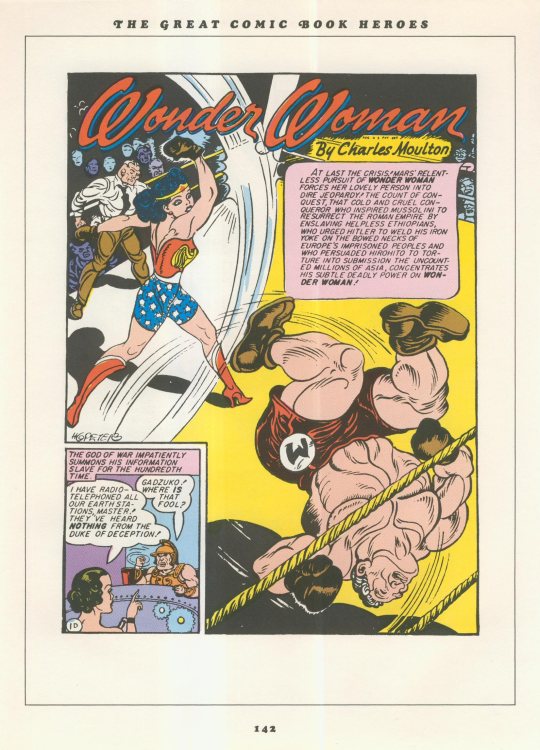
Next came an adventure of Hawkman, sourced from FLASH COMICS #5. Here, Feiffer skipped the earliest adventures of the winged wonder so as to showcase the work of Shelly Moldoff on the strip (and in particular how often he was swiping Flash Gordon panels by Alex Raymond, which happened everywhere.) This was followed by a Wonder Woman story from WONDER WOMAN #2–actually, it was a single chapter of a four-chapter larger story, but I wouldn’t discover this for decades. Feiffer chose it as a good example of some of the strange sexuality that was operating under the hood of what at first glance appeared to be a patriotic heroine series. This was the stuff that really made Wonder Woman sizzle, and the lack of which one of the reasons why her series had such a lack of pop in the 60s and 70s.

Then came a Sub-Mariner adventure from MARVEL MYSTERY COMICS #7, by which point creator Bill Everett had worked out the bugs. I didn’t read it for several months, but essentially it’s an orgy of destruction, as Namor returns to Manhattan to carve out vengeance for his undersea race by wrecking and destroying his way across the city–he even at one point accosts Mayor Fiorello LaGuardia. There isn’t much plot, only carnage–and it ends with Namor’s friend Berry Dean warning him that the Human Torch would be on his trail. But that historic meeting wasn’t included.
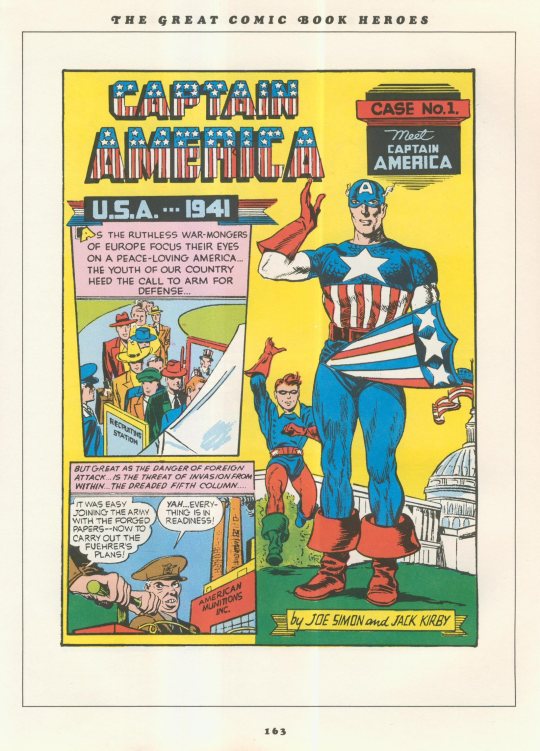
I also skipped the origin of Captain America, from CAPTAIN AMERICA COMICS #1. It’s a pretty crude piece of work, like most of what was reprinted in this volume. There are only hints of the explosiveness that Jack Kirby would bring to the comic book page in the next few issues, to say nothing of the next few decades. The pages were a little bit more jigsaw puzzle-y, but only a little bit. That would change as Kirby got going on Cap.

Next came the first Plastic Man adventure, from POLICE COMICS #1, and which I’d read a few weeks earlier in SECRET ORIGINS OF THE SUPER DC HEROES. It was still a fun tale, but one that only hinted at the inventiveness that Jack Cole would bring to the character and to the page. I felt the same way about the Spirit based on the story that Feiffer reprinted here. He spent a lot of time talking up how innovative and impressive a series it was, but from this sampling, I just couldn’t see it. Part of that, no doubt, is that most scholars consider the best period of Eisner’s Spirit to run from around 1946-1950 or so. But Feiffer was working for Eisner for most of that period–he wrote several of the most memorable tales–and so his interest was in the earliest Spirit adventures, the ones he read as a kid.
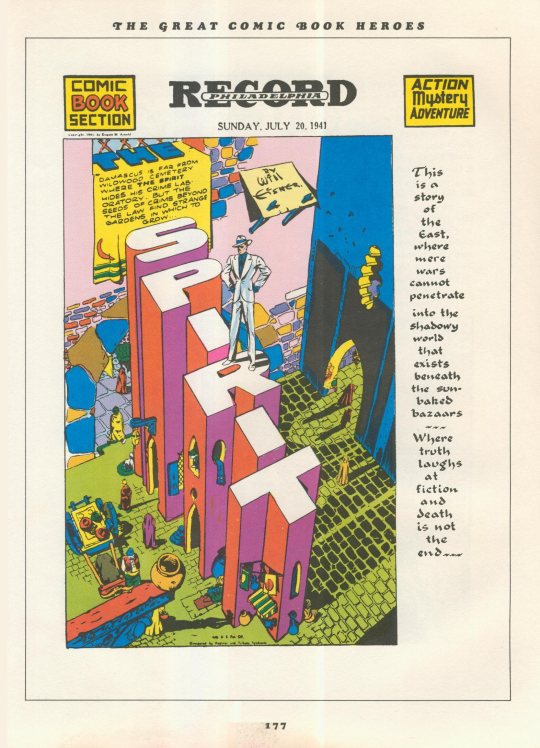
So it was a highly-enjoyable volume, and one that would have a greater impact on me over the course of time, but also slightly disappointing. But I was glad to have it, in particular because its existence came as a total surprise to me. At this point in time, there were precious few compilations of old comic book stories, so each one was like a treasured gem.
Post link
It was an unimaginable 41 year ago today, on Christmas day of 1976, that I finally got my hands on this much-desired beauty, a gift from Santa Claus. And actually, having asked for it specifically on the Christmas list that my mother would demand that each child write (usually sourced out of the Sears Christmas catalog, with an upper cap of $40.00 total), I wound up finding it among other gifts secreted away in our as-yet-unfinished attic, so I knew that it was coming at last.

To say that it was a treasure trove is underselling the situation. It’s unthinkable today, when so much classic material is readily available, either collected in book for or simply available digitally, but in the mid-1970s there wasn’t any way to read old comic book stories that you were interested in other than to find those old comics, or stumble across those stories being reprinted somewhere. So it was extremely difficult for a nine-year-old to make sense of the history of comics, as I was eager to do. Books like this one were invaluable and loved. Indeed, my original copy of this volume is in pieces, the cover and earliest pages having eventually fallen off–I had the paper cover edition, not the more expensive clothbound one. (I couldn’t for the life of me work out why anybody would spend the larger amount when they could have used that money to buy more comics. I get it now.)
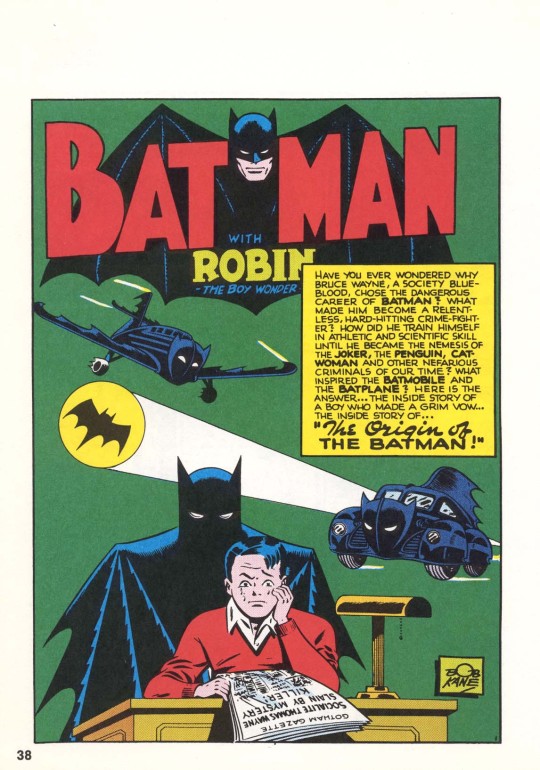
SECRET ORIGINS OF THE SUPER DC HEROES was the follow-up to Crown Books’ successful collections of vintage Superman and Batman stories. But it was really a reaction to Simon & Shuster’s ORIGINS OF MARVEL COMICS and its profitable follow-ups. Carmine Infantino and DC certainly wanted a piece of that marketplace (even if Carmine would be ousted as DC’s Publisher by the time the final product reached the marketplace in mid-1976). So the book is structured remarkably similarly to ORIGINS, with chapters devoted to ten DC heroes reprinting their origin stories (in most cases, two different ones from over the years) and introductory chapters written by Denny O’Neil outlining the behind-the-scenes story as to how these characters came to be.

Sadly, Denny is many wonderful things, but he’s not Stan Lee, so his secondhand recountings aren’t as engaging or fun to read as Stan’s–they read more like a homework assignment. It’s mostly the editors that Denny speaks to and who comment on the genesis of these heroes, and while they’re appreciative of the gainful employment such characters have provided them, you can’t help but get the feeling that it was all just a job to these guys.

Remarkably, the introduction to the Superman chapter speaks of Jerry Siegel and Joe Shuster, at a time when their byline was still stricken from the rolls at DC–this is notable in that, in that previous Superman collection that Crown had published years earlier, neither man was mentioned by name. Similarly, the Batman chapter talks about Bill Finger as well as Bob Kane–in fact, it mentions Finger’s name first. This was an extraordinary thing in 1976, and something that DC would walk back for at least a few more months on Jerry and Joe’s side, and for decades longer when it came to Finger. Whether this was due to Denny, or a desire to give a true accounting so as to mimic ORIGINS (whose accounting is far more compromised), it almost doesn’t matter.

The book also bridged the gap between the Golden Age and the more modern Silver Age, the Earth-1 and Earth-2 incarnations of the characters. In all but the final two instants, two stories were run featuring each character: their initial Golden Age appearance (or origin, in the case of Batman and Wonder Woman) and then either a more recent retelling or updating of that origin, or the origin or first appearance of the Silver Age incarnation of that hero. So you got Jay Garrick along with Barry Allen, Alan Scott besides Hal Jordan, and Al Pratt as well as Ray Palmer.
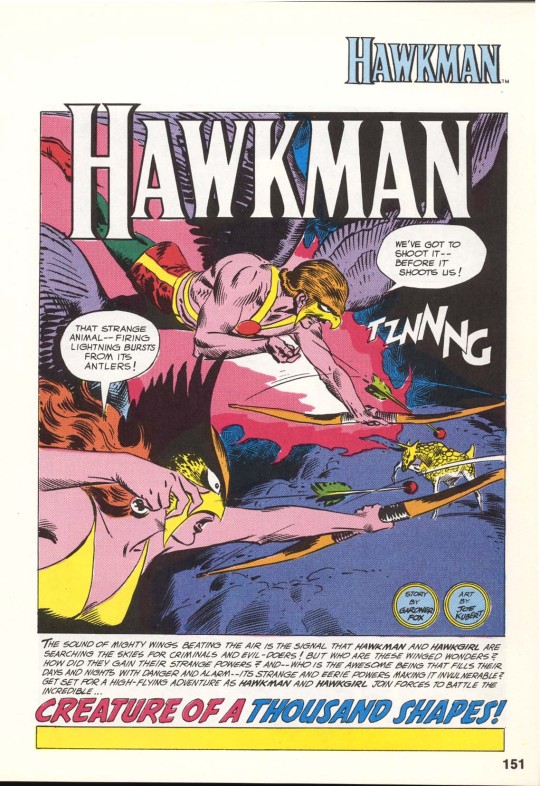
So, just walking through the volume a little bit, after some introductions and dedications (Sheldon Mayer!) it gets down to business with Superman, starting with a reprint of the first page of his initial story in ACTION COMICS #1 (which I’d already seen in the FAMOUS 1ST EDITION reprinting) followed by the expanded Origin of Superman from the AMAZING WORLD OF SUPERMAN special edition–this one I’d also previously read, in a SUPERMAN treasury Edition.

This is followed by the origin of Batman from BATMAN #1 (I’d read it) and then the well-regarded 1948 story in which Batman tracks down Joe Chill, the man who had killed his parents. It’s a story that packs a punch. Next came Wonder Woman, whose origin from the first issue of her comic was reproduced (Again, I’d read it in reprint before) followed by a more modern recounting by Robert Kanigher and Don Heck that also built up the mystery of Nubia, Diana’s long-lost sister.
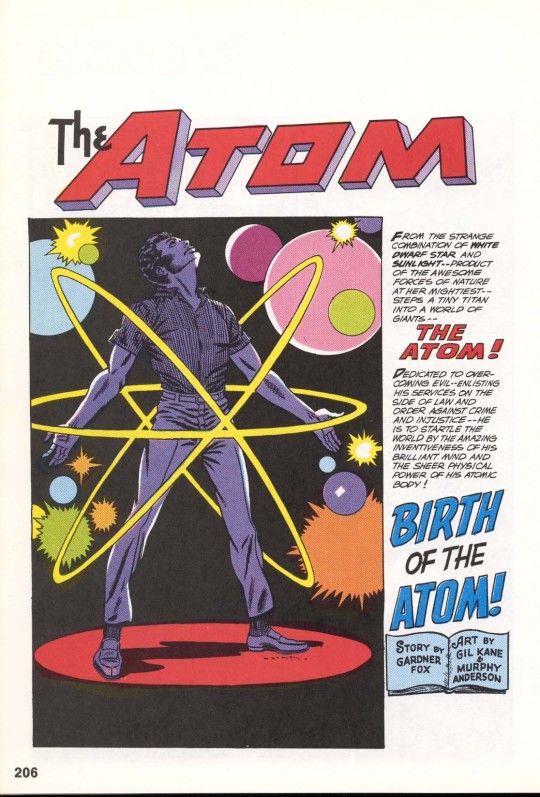
Then came the main event, the reason I had jonesed over this volume for so long: the origin of the Flash. It began with a reprint of the first Jay Garrick story (read it already!) and then reprinted the inaugural Barry Allen story from SHOWCASE #4. And I loved it, boy, every nonsensical second of it. This was followed by the first Green Lantern story, featuring Alan Scott–Scott doesn’t don his costume until the very last panel in this story, which was a bit disappointing–and then the first Hal Jordan tale (in which he does wear his costume, but no mask yet.) The fact that so many of DC’s characters had debuted in anthology titles, and so their stories were shorter than their Marvel competitors made it easier to fit more stories into a single volume.
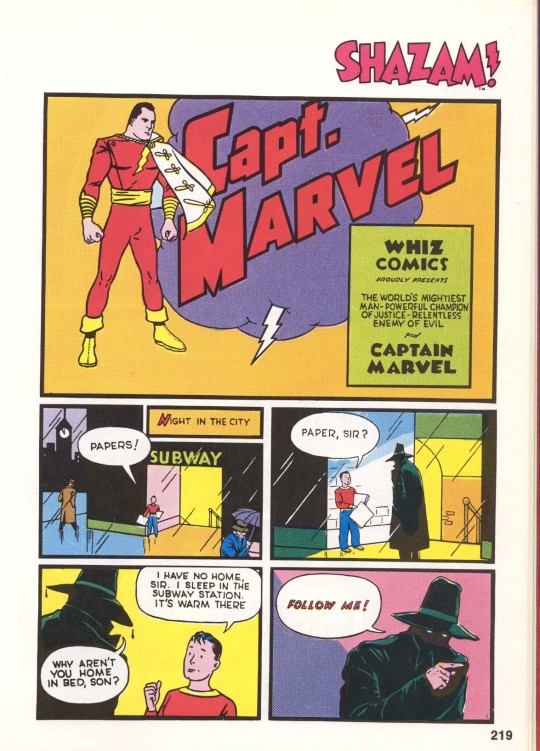
Then came two Hawkman origins (I’d read the first in the FLASH COMICS #1 Treasury, but not the Silver Age story) and a pair of Green Arrow stories, neither the Emerald Archer’s first appearance but both detailing contradictory origin stories for his costumed identity and mastery of the bow. I naturally concluded that the first must be the Earth-2 Green Arrow, which turned out to be true. The Atom came next, and he never even got a costume in his initial outing as Al Pratt, nor did Ray Palmer in his initial story. Still, these were all fun and inventive.

The final two slots in the book were devoted to DC “acquisitions” that had originated elsewhere. So next came the first Captain Marvel story from WHIZ COMICS #2 (the first issue had been an ashcan–and I’d read this story when #2 was reissued as a FAMOUS 1ST EDITION) and the first Plastic Man yarn from POLICE COMICS #1. This book is a treasured favorite, and I’ve replaced it twice over the years. It was also the start of what became a long Christmas tradition in which I would be given books on comics by my family, friends and relatives. And so it was a merry Christmas indeed.
Post link
Birds of Truth: UK Brotherhood - Project Crossfire
Assassin’s Creed Crossover Assassins
Gifs from sneakyzebra’sMCM Oct 2014 Cosplay Music Video
Post link
at this point in his career, I think directors just give Ryan Reynolds the plot to a movie and he just makes up the dialogue as he goes bc there is no way any of the shit he says in his movies is planned and not just him saying whatever he thinks would make the movie go on
This is my favorite Green Lantern trope - making something to carry people on that actually is really impractical.
(Catwoman V2 057)
Post link
Beyond his art, Neal Adams is rightfully remembered as an eternal champion of creators’ rights and for the part he & his work played in the Comics Code revision of ‘71 but his contribution to John Stewart’s creation is – I think – a rather underrated aspect of his career, especially as it’s such a great reminder of the kind of person he was. Taken from an interview conducted and transcribed by Allen W. Wright over at the Green Arrow: Bold Archer fansite, here’s Neal discussing John’s beginnings (x).
Post link
Hal Jordan likes to pretend to be the coolest person in the Justice League but he absolutely does not know how to use any social media. He laughs at memes that are 15 years old.
this man spends more time off planet than he does on earth, there’s no way he would know how social media works even if he tried
Hal: Why has Lime Green become an evil color? It seems like a disproportionate amount of villains wear it
Oliver: we’re literally both green, genius
Hal:notlimegreen!
Oliver: *deep sigh*
There’s been an unexpected hiatus in new posts due to… well… summer.
Get out there and try to enjoy yourselves. We’ll be back with new posts as soon as the miserable Canadian weather returns.
scene of the Green Lantern Corps chillin’ in the pool from Millennium #1 (1988). Illustrated by Joe Staton.
Post link
Green Lantern v2 (Marv Wolfman’s run)
AfterGreen Arrow was evicted from the series,Green Lantern v2 began to get a whole lot better. Green Arrow already had a long residency as a feature in World Finest v1 since 1977 - so don’t feel too sorry for him. Denny O'Neil, who had been writing Green Lantern since it’s DC Explosion revival in 1976 (GreenLantern v2 #90), wrote another six issues after Green Arrow had been booted out of the series and then left DC to work for Marvel comics in 1980. In his last six issues of Green Lantern,O'Neil managed to return Hal Jordan to his roots - Carol Ferris was re-instated as a potential love interest, Thomas Kalmaku (AKA Pieface) was back to being his sidekick, and Hal Jordan was once again a test pilot for Ferris Airlines. Another element O'Neil brought back was Hal Jordan’s arch-nemesis Sinestro - most of O'Neil’s final six issues involved a running plot of Hal Jordan battling Sinestro (with a dash of classic Green Lantern villains Hector Hammond and Star Sapphire thrown in for good measure). Whether it was a good time for O'Neil to cut and run from DC was up for debate as he had previously killed off Batwoman (Kathy Kane) in the pages ofDetective Comics that very same summer.
Green Lantern v2 issues #130 to #132 had guest writers. Bob Rozakis wrote issue #130, Mike W Barr wrote #131 and Paul Kupperberg wrote issue #132. What’s noteworthy about these issues is that we’re starting to see more of Green Lantern’s classical villains appear (Sonar and Evil Star). Another interesting development was occurring: now that Green Lantern wasn’t tethered to Green Arrow, there was more room to explore the Green Lantern mythos, and that included the Green Lantern Corps. The Green Lantern Corps played a prominent role in a few of O'Neil’s post-Green Arrow issues, but more importantly, the Green Lantern Corps received a back-up feature in Green Lantern v2 #130. Written by Bob Toomey and drawn by Alex Saviuk, the Green Lantern Corps stories were some previously completed but unpublished work that finally had a chance to be printed. Fans loved the concept and demanded more Green Lantern Corps stories. [more about that later]
Green Lantern v2 #132 saw a price jump from forty to fifty cents - this involved an extra eight pages of story and this is when Adam Strange became a back-up feature. Written by Jack C Harris and illustrated by Rodin L Rodriguez, the Adam Strange back-ups would run until Green Lantern v2 #147 (but not before switching creative teams to Laurie Sutton as writer and Carmine Infantino as artist). There would be another price increase to 60 cents by issue #144, for an extra 2 pages of story in 1981.
Marv Wolfman became the regular writer for Green Lantern v2 at issue #133. DC comics acquired the talented Mr. Wolfman after he had just left Marvel comics due to a dispute with Marvel’s editor-in-chief, Jim Shooter. Building on the momentum of O'Neil’s ‘back-to-basics’ approach for Hal Jordan, the first thing Wolfman did when he started writing Green Lantern was to shine up all of Hal Jordan’s relationships that had gotten a little vague over the last 20 years. He aimed to bring Hal and Carol Ferris back together, get all the characters set up, give Hal some new friends and create a new support cast as a launching pad for more stories. Wolfman also continued with the hit parade of classic Green Lantern villain appearances: Dr Polaris, Goldface, and Black Hand all appeared during Wolfman’s run. Interesting to note that Wolfman tried to make Goldface THE arch-foe of Hal Jordan. He wanted a foe whose super-powers were less important than the threat of his very existence. Wolfman also brought back an old one-time Green Lantern foe, The Tattooed Man, only to have him killed off*. This was possibly one of the first times a Green Lantern foe had been killed off - fans were a little annoyed by that little stunt. Wolfman explained that the Tattooed Man was killed off because his powers weren’t unique. Wolfman introduces the Omega Men (and the Vegan Star System) in Green Lantern v2 #141 (this would spin-off into it’s own series).
Long-time readers will most likely remember Wolfman as the writer who 'humanized’ Hal Jordan. Wolfman believed that what made a series work were the characters - if they are interesting and if their problems are engrossing. He believed that a blend of good stories, good characters and situations, coupled with interesting action sequences was the key to a successful series. Wolfman and his editors (Jack C Harris,Len Wein,Cary BurkettandDave Manak) decided to infuse a stronger personality in Hal Jordan (more so than done in the past). Wolfman really tried to get to the 'root’ of Hal Jordan. Another interesting plot element that Wolfman likes to explore is the masked crime fighter versus the legal system angle (as seen in Green Lantern v2 #145 - #146) - Wolfman would further explore this idea in his 1983Vigilanteseries.
As you are also probably well aware, Marv Wolfman was the mastermind behind the Crisis On Infinite Earths event - a grand gesture intended to make DC’s continuity way less confusing. You begin to recognize that Wolfman was making a concentrated effort to establish a DC-wide continuity in his Green Lantern v2run:
1. Re-introduction of older characters to a modern audience. These include Space Ranger from Green Lantern v2 #136 - #137, and Bruce Gordon/Eclipso from Green Lantern v2 #136 - #138.Wolfman is a stickler for cohesion, and demonstrating that characters from the old DC anthologies were still an active part of DC continuity is a major part of crafting a sense that everything is tied together and occupying the same universe.
2. Integrating characters from another title into the storyline. The Gordanians make an appearance and the H.I.V.E. are mentioned. Both sets of characters are from the New Teen Titans series that Wolfman was also writing at the same time. Most fans don’t realize this, but Wolfman was writing New Teen Titans,Action ComicsandAdventure Comics while he was writing Green Lantern v2. Integrating characters from another series as a way to create cohesion within the DC universe.
3. Answers the age-old question: if Hal Jordan was facing a global threat, where were all the other heroes? During Green Lantern’s battle with Eclipso, Wolfman made a point to show the rest of the Justice League’s efforts in combating the threat. Trying to keep the idea that although all of these characters occupy different comic book titles, they all occupy the same planet.
4.Wolfman addresses problems about Green Lantern v2 not meshing with prior DC history (case in point: Green Lantern v2 #136-#137 contradicts 1978’s Showcase #100).Wolfman explains that someday soon they will straighten all of that out (pre-lude to Crisis on Infinite Earths?).
5.Wolfman later incorporates some pre-existing Guardians of OA history into Crisis on Infinite Earths. The scene where a rogue Guardian (Krona) tries to view the creation of the universe thus unleashing the anti-monitor already existed prior to Crisis on Infinite Earths being written - Wolfman just retconned it slightly without altering anything major to meet the story’s needs. The Guardians of OA would come to play a major part in post-Crisis DC continuity (see: Millennium event)
The last issue of Wolfman’sGreen Lantern v2 run was issue #151 - after which he plotted issues #152 and #153 (while Gary CohnandDan Mishkin scripted) and became co-editor with Ernie Colon shortly thereafter. Wolfman dropped the series because he was too busy with the Teen Titans,Action Comicsandthe new horror/adventure series that he was planning.Wolfman left the series sending Hal Jordan in a new sci-fi direction (banished from earth by the Guardians of OA), his view was to get Hal off of Earth - Wolfman reasoned that Hal should be the Green Lantern of his entire space sector, not just the planet Earth. Green Lantern v2 #155 was the last issue pencilled by Joe Staton(Keith Pollard took over pencilling chores afterwards) - Staton would return as regular Green Lantern penciller two years later.
What was Wolfman’s impact on Green Lantern during his two year run? Green Lantern’s sales were very good when Wolfman took over, but dipped quite badly after the Space Ranger story arc. Sales of the series started climbing again after the introduction of the Omega Men. Sales for Green Lantern v2 were really high as of issue #147, so Wolfman left the series in pretty good health when Mike W Barr took over as regular writer.
WhileWolfman’s excellent writing, characterization and new direction for the series during this time period is definitely worth noting, I’d say the biggest development during this two year period was the Green Lantern Corps taking a more prominent role in the Green Lantern mythos. The Green Lantern Corps appeared in Green Lantern v2 #127(whileO'Neil was writing) and there seemed to be a pretty good response from the fans, so the Corps started to get a little bit more exposure in the series.
In 1981, a 3 issue mini-series written by Len WeinandMike W Barr was published titled Tales of the Green Lantern Corps that mainly focused on the Corps as a single unit (this included Hal Jordan). Various Green Lantern stories in the past had featured alien Green Lanterns in one-off team-up stories, but suddenly it was made aware that the Green Lantern Corps consisted of a diverse race of aliens with it’s own culture. The critical and sales impact of the Tales of Green Lantern Corps mini-series had a notable impact on Green Lantern v2 - lead stories began to have more alien Green Lantern Corps members and, as a result, more Green Lantern Corps members (Ch'P, Salaak, Arisia, Galius Zed, etc…) were introduced in the pages of Green Lantern v2. The Green Lantern Corps were so popular with the readers that the Adam Strange back-up feature was removed (#148) in favor of more Green Lantern Corps back-up features appearing instead. Paul Kupperberg (who was fresh on his stint from DC’s Ghosts) was writing said back-up tales and Don Newtonand/orCarmine Infantino was illustrating. Incedentaly, Kupperberg/Infantino also worked together on 1982’s New Adventures of Supergirlseries.
*In possibly THE most obscure spin-off ever, the Tattooed Man received his own Vertigo mini-series in 1993: Skin Graft: The Adventures of a Tattooed Man written by Jerry Prosser and illustrated by Warren Pleece.
Post link







